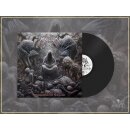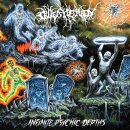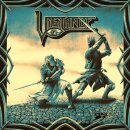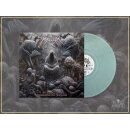Nuclear War Now, die hard triple coloured vinyl, bonus 7" gatefold, poster, patch, The origin of satanic heavy metal, which eventually assumed the title of "black metal," is most commonly linked to the British trio, Venom, who bestowed the name upon the subgenre with the title of its second album in 1982. In the decades since, black metal has undergone several periods of evolution, which have often been cultivated in self-contained, stylistic incubation regions in different parts of the world. In retrospect, one unlikely context of this sort was Poland in the early 1980s, which was dominated by pro-communist martial law, and from which the band Kat somehow emerged. Kat's role in the development of black heavy metal is one that is typically overlooked, but it is one of significance that deserves proper recognition. Kat was formed in 1979 under the direction of guitarist Piotr Luczyk and in conspiracy with Ireneusz Loth on drums. Shortly thereafter, Tomasz Jaguś (bass) and Ryszard Pisarski (guitars) joined the band, and during the first two years of its existence, this quartet exclusively played instrumental songs inspired by the likes of Deep Purple, Black Sabbath, Judas Priest, and Accept. Although he was not the first vocalist to try out for Kat, Roman Kostrzewski solidified the band with his enlistment in 1981, enabling Kat to take the necessary next step of performing songs with vocals. Coincidentally, during the year of Kostrzewski's addition to the band, Wojciech Jaruzelski imposed martial law throughout Poland in an effort to suppress any and all anti-communist sentiment in the country. Thus, Kat's formative years were set against the backdrop of military rule that sought to censor the very types of expression that Kat intended to propagate. However, as is often the case, the artistic suppression that characterized life behind the Iron Curtain instead led to a greater urgency for rebellion, as evidenced by the darker turn taken by the post punk and new wave genres that were popular at the time. Similarly, Kat's musical direction became increasingly focused on themes related to satanism, murder, and vampirism, among others of the same ilk. This confluence of events would therefore result in Kat's role as a pioneer in the development of the black heavy metal subgenre, albeit to a less recognized degree than its British contemporaries in Venom, whose "Welcome to Hell" opus was released that very same year. One of the greatest outlets of cultural rebellion in all of Eastern Europe at the time was the annual Jarocin Festival, which took place in the western region of Poland and is regarded by many as the birthplace of punk rock under communist rule. In 1984, following the replacement of Ryszard Pisarski by Wojciech Mrowiec on guitars, and again in 1985, Kat was invited to the band competition at the Jarocin Festival. Kat succeeded in gaining some attention from these performances as a result of its fast and aggressive brand of heavy metal and the dark themes of its music, which contrasted with the more prevalent topics of partying and social issues that dominated the music of other participants. Thanks to the antics of Kat's compatriots in the already-established Tajne Stowarzyszenie Abstynentów (TSA), Polish metal fans had already been exposed to some raucous stage acts. TSA was known for creating a riot-like atmosphere characterized by excessive volume, partial or full on-stage nudity, and the violence of random objects regularly being thrown into the crowd. Kat, however, upped the ante by including fire in its act, early on by fashioning a flag mast into a makeshift launcher of explosives, and later by including a more complete array of pyrotechnics. The result was one in which the band's unhinged stage presence matched the fury of its audial onslaught. Not long after its early successes in the Jarocin Festivals, Kat entered the studio to record its debut seven-inch single, "Ostatni tabor / Noce Szatana" ("The Last Supply Train / The Nights of Satan"), which was released by the Polish label Tonpress in 1985 and featured a uniquely engraved center label instead of the typical paper variety. Within approximately one year, the band reentered the studio in October and November of 1985 to record what would essentially become two versions of the same album. One of these, simply entitled "666," was recorded with Polish lyrics, whereas its evil twin, "Metal and Hell," was recorded in English. Further confounding the situation, there were two versions of "666," one of which was composed of alternate recordings of the same songs, which were also presented in a different order but never released to the public. The better-known version of "666" was released on both cassette and twelve-inch vinyl by two different Polish labels. Meanwhile, "Metal and Hell" was released by Ambush Records in Belgium and the Polish label Pronit approximately one year later. Although the "666" and "Metal and Hell" albums reflect the bands musical influences of standard heavy metal bands like Judas Priest and Accept, they also diverge substantially in the presence of a much darker atmosphere, content, and delivery. The albums' production is one that seems to recreate the setting of a cavernous medieval torture chamber. This, of course, is appropriate, given the fact that the band's name translates to "Executioner" in English. Most tracks flourish in the mid to upper tempos of metal from the era, a characteristic which lends itself well to the effect the band intended to nurture. That said, even the ballad, “Czas Zemsty” (“Time of Revenge”), takes on a much more sinister tone than the most comparable songs from the era (see Accept, for example). The unmistakable truth is that the overall product of "666" and "Metal and Hell" was extreme according to international standards of the time, and thus it was that much more so for a band establishing itself within the suppressive confines of an Eastern Bloc nation. Since the 1986 release of "666" and "Metal and Hell," Kat has gone on to record and release eight full-length albums, as well as several EPs, splits, and live sets. As of the 2022 writing of this biography, the band is still active, after close to forty-five years since its inception. Nonetheless, its twin debut albums are the landmarks by which the band shall always be remembered most. In fact, the track "Wyrocznia" is still a staple of a Kat live performance, even after the intervening multiple decades of stylistic transformation that the band has experienced. In short, the culmination of Kat's formative years as expressed in "666" and "Metal and Hell" is one that has left an indelible mark on black metal's historical trajectory, not only in Eastern Europe, but in the world at large.
| Artikelgewicht: | 1,20 kg |
Importeur/Verantwortlicher:
Name: High Roller Records
Anschrift: Bertolt-Brecht-Str. 1a, 08412 Werdau, Deutschland
E-Mail: info@hrrshop.de





